python垃圾回收机制
转载自: http://my.oschina.net/hebianxizao/blog/57367
现在的高级语言如java,c#等,都采用了垃圾收集机制,而不再是c,c++里用户自己管理维护内存的方式。自己管理内存极其自由,可以任意申请内存,但如同一把双刃剑,为大量内存泄露,悬空指针等bug埋下隐患。
1 |
typedef struct_object { |
2 |
int ob_refcnt; |
3 |
struct_typeobject *ob_type; |
4 |
}PyObject; |
1 |
#define Py_INCREF(op) ((op)->ob_refcnt++) //增加计数 |
2 |
#define Py_DECREF(op) \ //减少计数 |
3 |
if (--(op)->ob_refcnt != 0) \ |
4 |
; \ |
5 |
else \ |
6 |
__Py_Dealloc((PyObject *)(op)) |
1 |
list1 = [] |
2 |
list2 = [] |
3 |
list1.append(list2) |
4 |
list2.append(list1) |
上面说到python里回收机制是以引用计数为主,标记-清除和分代收集两种机制为辅。
1、标记-清除机制
标记-清除机制,顾名思义,首先标记对象(垃圾检测),然后清除垃圾(垃圾回收)。如图1:
图1
首先初始所有对象标记为白色,并确定根节点对象(这些对象是不会被删除),标记它们为黑色(表示对象有效)。将有效对象引用的对象标记为灰色(表示对象可达,
但它们所引用的对象还没检查),检查完灰色对象引用的对象后,将灰色标记为黑色。重复直到不存在灰色节点为止。最后白色结点都是需要清除的对象。
2、回收对象的组织
这里所采用的高级机制作为引用计数的辅助机制,用于解决产生的循环引用问题。而循环引用只会出现在“内部存在可以对其他对象引用的对象”,比如:list,class等。
为了要将这些回收对象组织起来,需要建立一个链表。自然,每个被收集的对象内就需要多提供一些信息,下面代码是回收对象里必然出现的。
一个对象的实际结构如图2:
图2
通过PyGC_Head的指针将每个回收对象连接起来,形成了一个链表,也就是在1里提到的初始化的所有对象。
3、分代技术
分代技术是一种典型的以空间换时间的技术,这也正是java里的关键技术。这种思想简单点说就是:对象存在时间越长,越可能不是垃圾,应该越少去收集。
这样的思想,可以减少标记-清除机制所带来的额外操作。分代就是将回收对象分成数个代,每个代就是一个链表(集合),代进行标记-清除的时间与代内对象
存活时间成正比例关系。
从上面代码可以看出python里一共有三代,每个代的threshold值表示该代最多容纳对象的个数。默认情况下,当0代超过700,或1,2代超过10,垃圾回收机制将触发。
0代触发将清理所有三代,1代触发会清理1,2代,2代触发后只会清理自己。
下面是一个完整的收集流程:链表建立,确定根节点,垃圾标记,垃圾回收~
1、链表建立
首先,中里在分代技术说过:0代触发将清理所有三代,1代触发会清理1,2代,2代触发后只会清理自己。在清理0代时,会将三个链表(代)链接起来,清理1代的时,会链接1,2两代。在后面三步,都是针对的这个建立之后的链表。
2、确定根节点
图1为一个例子。list1与list2循环引用,list3与list4循环引用。a是一个外部引用。
图1
对于这样一个链表,我们如何得出根节点呢。python里是在引用计数的基础上又提出一个有效引用计数的概念。顾名思义,有效引用计数就是去除循环引用后的计数。
下面是计算有效引用计数的相关代码:
01 |
/* Set all gc_refs = ob_refcnt. After this, gc_refs is > 0 for all objects |
02 |
* in containers, and is GC_REACHABLE for all tracked gc objects not in |
03 |
* containers. |
04 |
*/ |
05 |
static void |
06 |
update_refs(PyGC_Head *containers) |
07 |
{ |
08 |
PyGC_Head *gc = containers->gc.gc_next; |
09 |
for (; gc != containers; gc = gc->gc.gc_next) { |
10 |
assert(gc->gc.gc_refs == GC_REACHABLE); |
11 |
gc->gc.gc_refs = Py_REFCNT(FROM_GC(gc)); |
12 |
assert(gc->gc.gc_refs != 0); |
13 |
} |
14 |
} |
15 |
16 |
/* A traversal callback for subtract_refs. */ |
17 |
static int |
18 |
visit_decref(PyObject *op, void *data) |
19 |
{ |
20 |
assert(op != NULL); |
21 |
if (PyObject_IS_GC(op)) { |
22 |
PyGC_Head *gc = AS_GC(op); |
23 |
/* We're only interested in gc_refs for objects in the |
24 |
* generation being collected, which can be recognized |
25 |
* because only they have positive gc_refs. |
26 |
*/ |
27 |
assert(gc->gc.gc_refs != 0); /* else refcount was too small */ |
28 |
if (gc->gc.gc_refs > 0) |
29 |
gc->gc.gc_refs--; |
30 |
} |
31 |
return 0; |
32 |
} |
33 |
34 |
/* Subtract internal references from gc_refs. After this, gc_refs is >= 0 |
35 |
* for all objects in containers, and is GC_REACHABLE for all tracked gc |
36 |
* objects not in containers. The ones with gc_refs > 0 are directly |
37 |
* reachable from outside containers, and so can't be collected. |
38 |
*/ |
39 |
static void |
40 |
subtract_refs(PyGC_Head *containers) |
41 |
{ |
42 |
traverseproc traverse; |
43 |
PyGC_Head *gc = containers->gc.gc_next; |
44 |
for (; gc != containers; gc=gc->gc.gc_next) { |
45 |
traverse = Py_TYPE(FROM_GC(gc))->tp_traverse; |
46 |
(void) traverse(FROM_GC(gc), |
47 |
(visitproc)visit_decref, |
48 |
NULL); |
49 |
} |
50 |
} |
update_refs函数里建立了一个引用的副本。
visit_decref函数对引用的副本减1,subtract_refs函数里traverse的作用是遍历对象里的每一个引用,执行visit_decref操作。
最后,链表内引用计数副本非0的对象,就是根节点了。
说明:
1、为什么要建立引用副本?
答:这个过程是寻找根节点的过程,在这个时候修改计数不合适。subtract_refs会对对象的引用对象执行visit_decref操作。如果链表内对象引用了链表外对象,那么链表外对象计数会减1,显然,很有可能这个对象会被回收,而回收机制里根本不应该对非回收对象处理。
2、traverse的疑问(未解决)?
答:一开始,有个疑问。上面例子里,subtract_refs函数中处理完list1结果应该如下:
然后gc指向list2,此时list2的副本(为0)不会减少,但是list2对list1还是存在实际上的引用,那么list1副本会减1吗?显然,如果减1就出问题了。
所以list1为0时,traverse根本不会再去处理list1这些引用(或者说,list2对list1名义上不存在引用了)。
此时,又有一个问题,如果存在一个外部对象b,对list2引用,subtract_refs函数中处理完list1后,如下图:
当subtract_refs函数中遍历到list2时,list2的副本还会减1吗?显然traverse的作用还是没有理解。
3、垃圾标记
接下来,python建立两条链表,一条存放根节点,以及根节点的引用对象。另外一条存放unreachable对象。
标记的方法就是中里的标记思路,代码如下:
001 |
/* A traversal callback for move_unreachable. */ |
002 |
static int |
003 |
visit_reachable(PyObject *op, PyGC_Head *reachable) |
004 |
{ |
005 |
if (PyObject_IS_GC(op)) { |
006 |
PyGC_Head *gc = AS_GC(op); |
007 |
const Py_ssize_t gc_refs = gc->gc.gc_refs; |
008 |
009 |
if (gc_refs == 0) { |
010 |
/* This is in move_unreachable's 'young' list, but |
011 |
* the traversal hasn't yet gotten to it. All |
012 |
* we need to do is tell move_unreachable that it's |
013 |
* reachable. |
014 |
*/ |
015 |
gc->gc.gc_refs = 1; |
016 |
} |
017 |
else if (gc_refs == GC_TENTATIVELY_UNREACHABLE) { |
018 |
/* This had gc_refs = 0 when move_unreachable got |
019 |
* to it, but turns out it's reachable after all. |
020 |
* Move it back to move_unreachable's 'young' list, |
021 |
* and move_unreachable will eventually get to it |
022 |
* again. |
023 |
*/ |
024 |
gc_list_move(gc, reachable); |
025 |
gc->gc.gc_refs = 1; |
026 |
} |
027 |
/* Else there's nothing to do. |
028 |
* If gc_refs > 0, it must be in move_unreachable's 'young' |
029 |
* list, and move_unreachable will eventually get to it. |
030 |
* If gc_refs == GC_REACHABLE, it's either in some other |
031 |
* generation so we don't care about it, or move_unreachable |
032 |
* already dealt with it. |
033 |
* If gc_refs == GC_UNTRACKED, it must be ignored. |
034 |
*/ |
035 |
else { |
036 |
assert(gc_refs > 0 |
037 |
|| gc_refs == GC_REACHABLE |
038 |
|| gc_refs == GC_UNTRACKED); |
039 |
} |
040 |
} |
041 |
return 0; |
042 |
} |
043 |
044 |
/* Move the unreachable objects from young to unreachable. After this, |
045 |
* all objects in young have gc_refs = GC_REACHABLE, and all objects in |
046 |
* unreachable have gc_refs = GC_TENTATIVELY_UNREACHABLE. All tracked |
047 |
* gc objects not in young or unreachable still have gc_refs = GC_REACHABLE. |
048 |
* All objects in young after this are directly or indirectly reachable |
049 |
* from outside the original young; and all objects in unreachable are |
050 |
* not. |
051 |
*/ |
052 |
static void |
053 |
move_unreachable(PyGC_Head *young, PyGC_Head *unreachable) |
054 |
{ |
055 |
PyGC_Head *gc = young->gc.gc_next; |
056 |
057 |
/* Invariants: all objects "to the left" of us in young have gc_refs |
058 |
* = GC_REACHABLE, and are indeed reachable (directly or indirectly) |
059 |
* from outside the young list as it was at entry. All other objects |
060 |
* from the original young "to the left" of us are in unreachable now, |
061 |
* and have gc_refs = GC_TENTATIVELY_UNREACHABLE. All objects to the |
062 |
* left of us in 'young' now have been scanned, and no objects here |
063 |
* or to the right have been scanned yet. |
064 |
*/ |
065 |
066 |
while (gc != young) { |
067 |
PyGC_Head *next; |
068 |
069 |
if (gc->gc.gc_refs) { |
070 |
/* gc is definitely reachable from outside the |
071 |
* original 'young'. Mark it as such, and traverse |
072 |
* its pointers to find any other objects that may |
073 |
* be directly reachable from it. Note that the |
074 |
* call to tp_traverse may append objects to young, |
075 |
* so we have to wait until it returns to determine |
076 |
* the next object to visit. |
077 |
*/ |
078 |
PyObject *op = FROM_GC(gc); |
079 |
traverseproc traverse = Py_TYPE(op)->tp_traverse; |
080 |
assert(gc->gc.gc_refs > 0); |
081 |
gc->gc.gc_refs = GC_REACHABLE; |
082 |
(void) traverse(op, |
083 |
(visitproc)visit_reachable, |
084 |
(void *)young); |
085 |
next = gc->gc.gc_next; |
086 |
} |
087 |
else { |
088 |
/* This *may* be unreachable. To make progress, |
089 |
* assume it is. gc isn't directly reachable from |
090 |
* any object we've already traversed, but may be |
091 |
* reachable from an object we haven't gotten to yet. |
092 |
* visit_reachable will eventually move gc back into |
093 |
* young if that's so, and we'll see it again. |
094 |
*/ |
095 |
next = gc->gc.gc_next; |
096 |
gc_list_move(gc, unreachable); |
097 |
gc->gc.gc_refs = GC_TENTATIVELY_UNREACHABLE; |
098 |
} |
099 |
gc = next; |
100 |
} |
101 |
} |
标记之后,链表如上图。
4、垃圾回收
回收的过程,就是销毁不可达链表内对象。下面代码就是list的清除方法:
01 |
/* Methods */ |
02 |
03 |
static void |
04 |
list_dealloc(PyListObject *op) |
05 |
{ |
06 |
Py_ssize_t i; |
07 |
PyObject_GC_UnTrack(op); |
08 |
Py_TRASHCAN_SAFE_BEGIN(op) |
09 |
if (op->ob_item != NULL) { |
10 |
/* Do it backwards, for Christian Tismer. |
11 |
There's a simple test case where somehow this reduces |
12 |
thrashing when a *very* large list is created and |
13 |
immediately deleted. */ |
14 |
i = Py_SIZE(op); |
15 |
while (--i >= 0) { |
16 |
Py_XDECREF(op->ob_item[i]); |
17 |
} |
18 |
PyMem_FREE(op->ob_item); |
19 |
} |
20 |
if (numfree < PyList_MAXFREELIST && PyList_CheckExact(op)) |
21 |
free_list[numfree++] = op; |
22 |
else |
23 |
Py_TYPE(op)->tp_free((PyObject *)op); |
24 |
Py_TRASHCAN_SAFE_END(op) |
25 |
} |



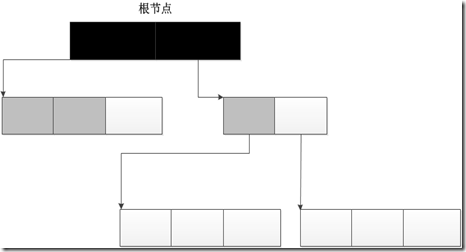
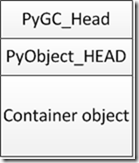

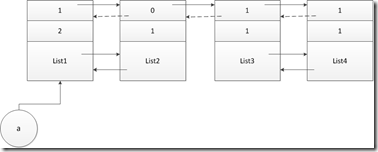
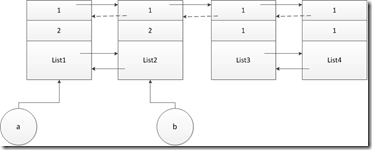
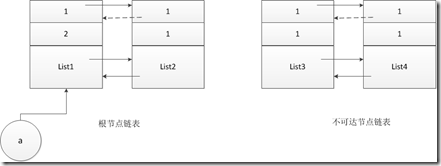

 浙公网安备 33010602011771号
浙公网安备 33010602011771号